Have you stumbled upon a 1925 penny in your pocket change? If so, you might be curious about its value. You’re in the right place to uncover the worth of this vintage coin!
In this article, we’ll delve into the value of the 1925 penny, exploring the factors that influence its price. We’ll examine different mint marks and grades, and highlight some intriguing error coins that have surfaced over the years.
Ready to learn more? Let’s dive in!
Value Chart for 1925 Penny
| Mint Mark | XF45 | MS60 | MS65 | MS66 |
|---|---|---|---|---|
| 1925 No Mint Mark Penny Value | Brown: $10 | Brown: $22 | Brown: $150 | Brown: $225 |
| Red and Brown: $25 | Red and Brown: $160 | Red and Brown: $300 | ||
| Red: $26 | Red: $250 | Red: $475 | ||
| 1925 D Penny Value | Brown: $24 | Brown: $85 | Brown: $400 | Brown: $2,650 |
| Red and Brown: $100 | Red and Brown: $925 | Red and Brown: $3,000 | ||
| Red: $125 | Red: $4,000 | Red: $93,000 | ||
| 1925 S Penny Value | Brown: $25 | Brown: $135 | Brown $1,050 | Brown: $3,850 |
| Red and Brown: $150 | Red and Brown: $3,200 | NA | ||
| Red: $300 | Red: $50,000 | NA |
Historical Significance of the 1925 Penny

The 1925 penny is part of a significant series in U.S. numismatic history, known as the Lincoln penny. This coin was groundbreaking as it was the first to feature a real person on one side.
The inaugural Lincoln pennies were minted in 1909 to commemorate the 100th anniversary of President Abraham Lincoln’s birth. Prior to this, Lady Liberty typically graced the obverse (or “heads” side) of coins. Honoring a real person in this manner was once considered too reminiscent of monarchy.
However, as Lincoln’s centenary approached, public sentiment shifted. There was growing support for a Lincoln coin, championed by President Theodore Roosevelt.
Roosevelt likely recommended the coin’s designer, Victor David Brenner, a Lithuanian artist. Brenner had previously created a portrait of Roosevelt for a medal.
By the time Brenner was designing the Lincoln penny, Lincoln had long passed away. It’s believed that Brenner based his design on a photograph taken by the renowned photographer, Matthew Brady.
The earliest Lincoln pennies are often called “Wheat pennies” or “Wheaties” due to the reverse design featuring two ears of durum wheat. This is the design you’ll find on the back of your 1925 penny.
Fifty years later, the reverse design was updated to depict the Lincoln Memorial in Washington, D.C. The bicentennial of Lincoln’s birth brought another change, with four different reverse designs showcasing various stages of Lincoln’s life.
Today’s Lincoln pennies feature the “Union shield” on the reverse, but the portrait of Lincoln has remained unchanged, making it the longest-running design in U.S. coin history.
The composition of the Lincoln penny has also evolved. The original cents, including the 1925 penny, were made of bronze—95% copper and 5% zinc and tin.
In 1943, due to the need for copper and tin in wartime munitions, the penny was made of steel for that year only. As the price of copper increased, producing bronze pennies became more costly. In 1982, the composition changed to zinc with a copper cladding, maintaining the coin’s familiar color while reducing production costs.
If you compare a 1925 penny to a modern cent, you’ll notice it’s significantly heavier. Additionally, if you drop it on a wooden surface, the earlier penny will produce a distinct “ping” sound, unlike the modern one, which has a more muted, plasticky sound.
Design of the 1925 Penny
The 1925 penny is a fascinating piece of numismatic history, offering a glimpse into the past with its unique features and design elements. Let’s explore what makes this coin special.
Obverse Design of 1925 Penny

Despite the many changes in coinage over the years, the obverse design of the 1925 penny remains consistent with its modern counterparts. It proudly displays the iconic portrait of Abraham Lincoln, a design that has endured for over a century.
This profile of Lincoln, showing his head and shoulders facing right, was crafted by the talented artist Victor David Brenner. Brenner aimed to capture Lincoln’s likeness as if he were reading to a child, a detail that suggests he used a photograph taken by the famous photographer Matthew Brady, which depicted Lincoln with his young son.
If you look closely, you’ll notice Brenner’s initials at the bottom of the portrait. Initially, these initials appeared on the reverse of the 1909 pennies but were later removed due to their prominence. They were reintroduced on the obverse in 1918.
Above Lincoln’s image, you’ll find the phrase “IN GOD WE TRUST.” To the left is the word “LIBERTY,” and to the right, the date of minting. Pennies minted in Denver or San Francisco bear mint marks, while those from Philadelphia do not.
A Denver coin will have a small “D” beneath the date, and a San Francisco coin will have a small “S.”
Reverse Design of 1925 Penny
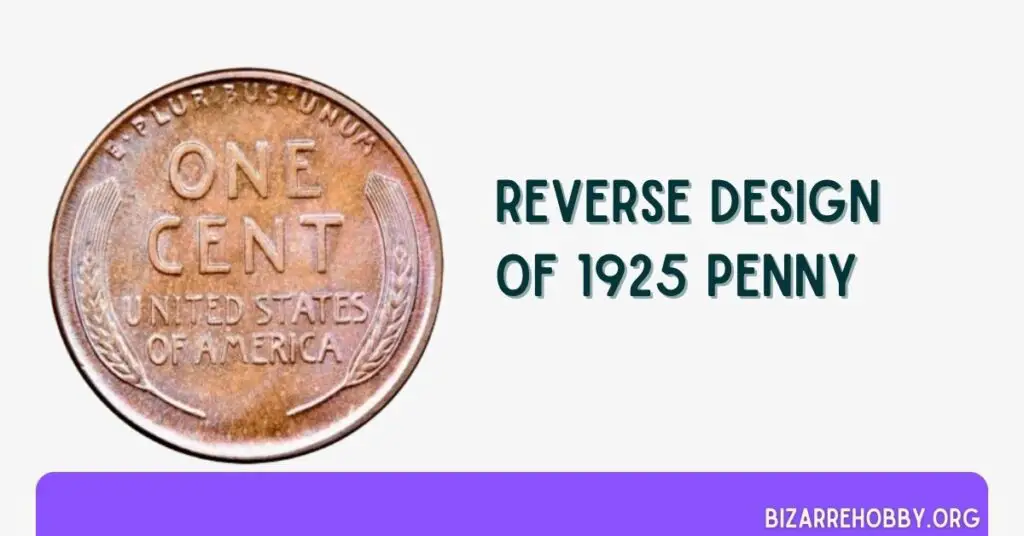
The reverse side of the 1925 penny, also designed by Victor David Brenner, features two stylized ears of durum wheat. This design frames the edges of the coin, with the denomination prominently displayed in the center. Below the denomination, you’ll find the name of the country in smaller font.
At the top of the reverse side, the Latin phrase “E PLURIBUS UNUM” arches along the upper edge. This phrase, meaning “From the many, one,” symbolizes the formation of the United States as a union of states.
Interestingly, Brenner’s initial design for the reverse featured a tree branch, but it was rejected for being too similar to contemporary French coins. The wheat ears were chosen as a distinctive alternative.
Technical Specifications of 1925 Penny
The high copper content of the 1925 penny results in significant color variations among individual coins. Coins that have seen limited handling or exposure to air retain the rich red hue of new copper, while those that have been in circulation tend to turn brown.
These color variations are crucial in determining a coin’s value. Independent grading agencies like the PCGS and NGC categorize bronze and copper coins based on their color: red, red and brown, or brown.
A coin must be at least 95% red to be classified as such, while a brown coin must be predominantly brown. Coins that don’t fit these criteria are graded as red and brown.
Grading Guide for 1925 Penny
| Sheldon Scale | Grade |
|---|---|
| 1 | Basal State-1 |
| 2 | Fair |
| 3 | Very Fair |
| 4, 5, 6 | Good |
| 7, 8, 10 | Very Good |
| 12, 15 | Fine |
| 20, 30 | Very Fine |
| 40 | Extremely Fine |
| 50 | About Uncirculated |
| 60 | Mint State |
| 65 | Mint State |
| 70 | Mint State |
Grading a 1925 penny is essential to determine its value accurately. The Sheldon Scale, a 70-point grading system, is widely used by collectors and grading services. This scale ranges from 1 (Poor) to 70 (Perfect Mint State). Here’s a brief overview:
- Poor (P-1): Barely identifiable, heavily worn.
- Good (G-4): Major details are visible but heavily worn.
- Very Fine (VF-20): Moderate wear on high points, all major details are clear.
- Extremely Fine (XF-45): Light wear on high points, nearly all details are sharp.
- About Uncirculated (AU-50): Slight wear on the highest points, full details.
- Mint State (MS-60 to MS-70): No wear, full mint luster, and sharp details.
Coins in higher grades, especially those in mint state, are significantly more valuable. The color of the coin (red, red and brown, or brown) also affects its value, with red coins generally being the most desirable.
1925 Penny Value Guides
The value of a 1925 penny can vary significantly based on its condition, mint mark, and color. Let’s explore the different factors that influence its worth.
1925 No Mint Mark Penny Value

In 1925, the Philadelphia Mint produced approximately 140 million Lincoln pennies, a relatively modest number compared to modern mintages. Today, it’s estimated that around 14 million of these coins still exist. While finding a 1925 penny without a mint mark isn’t particularly rare, most of these coins are in circulated condition and are brown in color.
Circulated coins generally have a modest value. However, if your 1925 penny is in mint state (uncirculated), it can be worth significantly more. The color of the coin also plays a crucial role in its value. Red and brown coins are typically more valuable than brown ones, with red coins being the most sought after.
Coin condition is graded on a scale from 1 to 70, with 1 being the poorest and 70 being perfect. Uncirculated coins are graded 60 and above, and those graded 65 or higher are considered “gems.”
- A brown 1925 no mint mark penny graded XF45 (extremely fine) is valued at around $10.
- The same coin graded MS60 (mint state) is worth approximately $22.
- A gem quality MS65 brown penny can fetch around $150.
Red and brown coins start at $25 for MS60 and can reach $300 at MS66. Red coins are even more valuable, starting at $26 for MS60 and going up to $1,400 at MS67. The highest known grade for a red 1925 penny is MS68, valued at an impressive $65,000.
1925 D Penny Value
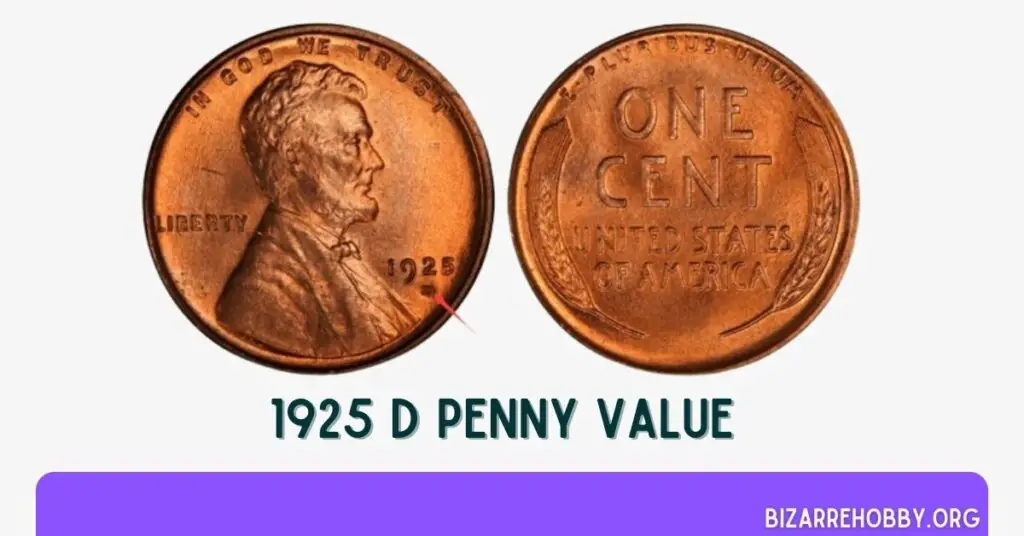
The Denver Mint produced significantly fewer pennies in 1925, with a mintage of 22,580,000 coins. Most of these are brown circulated examples, with only about 1,750 red coins believed to survive. Red gems are particularly rare, with an estimated 160 in existence.
- A brown XF45 1925 D penny is valued at around $24.
- At MS60, the value rises to approximately $85.
- The finest brown examples, graded MS66, are valued at $2,650.
Red and brown 1925 D pennies start at $100 for MS60 and can reach $925 at MS65. The highest grade for this color is MS66+, with a single coin valued at $6,500.
Red pennies are even more valuable, with MS60 examples worth around $125 and gem MS65 coins valued at $4,000. The finest known red 1925 D pennies, graded MS66, are valued at an astonishing $93,000.
1925 S Penny Value
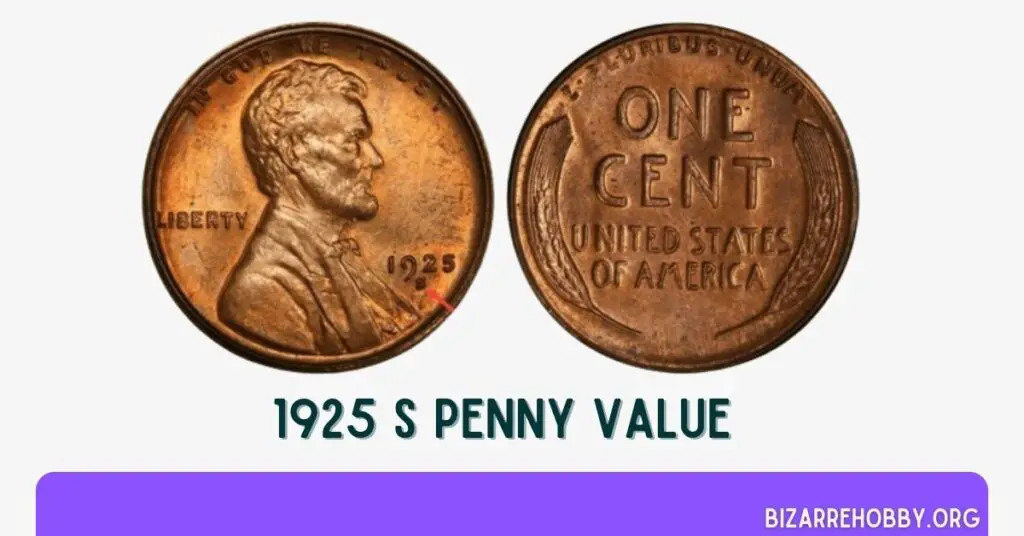
In 1925, the San Francisco Mint struck 26.3 million pennies for everyday use, identifiable by the “S” mint mark below the date. Approximately one in ten of these coins are believed to survive today, with around 1,200 in mint state and only 45 considered gems.
- A brown 1925 S penny in the poorest condition is worth about $1.
- At XF45, the value is around $25.
- In mint state, values start at $135.
Red and brown examples range from $150 at MS60 to $10,000 at MS65+, the highest grade certified for this color. Red pennies start at $300 for MS60, with the highest quality peaking at MS65. Fourteen coins have been certified at this level, each valued at $50,000.
Rare 1925 Penny Errors List
Error coins are highly sought after by collectors due to their rarity and unique characteristics. Here are some notable errors for the 1925 penny:
1925 S Penny Double Die Obverse Error
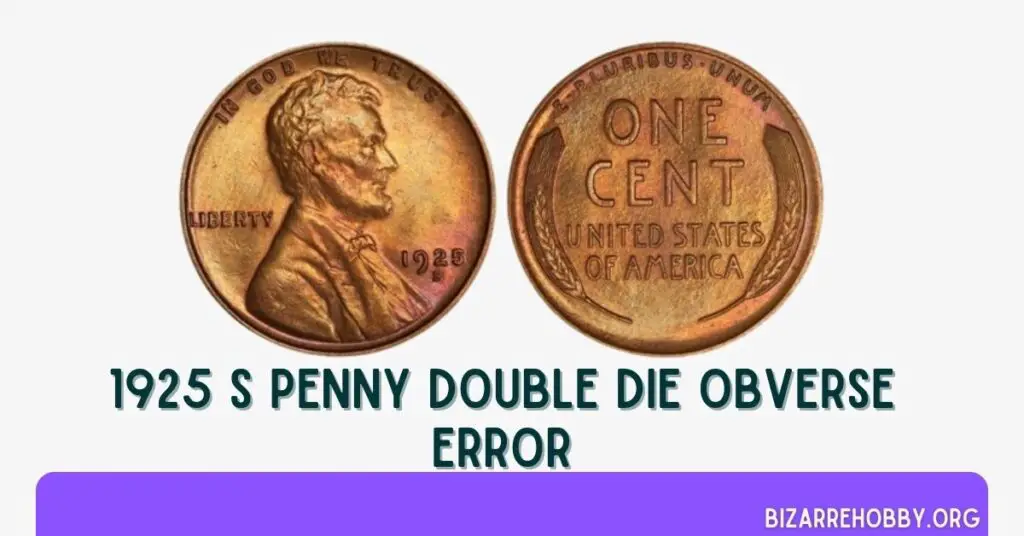
A double die obverse (DDO) error occurs when the die used to strike the coin’s design is struck more than once, causing a doubling effect. For the 1925 S penny, this error can be identified by extra thickness in the tail of the “9” in the date and a double line at the top of the “5”. These errors are subtle and often require a microscope or loupe to detect.
The value of a 1925 S double die obverse penny varies based on its condition:
- Poor Condition: Approximately $20
- XF45: Around $110
- MS60: About $250
- MS65 Brown: Valued at $1,450
1925 S Penny Re-punched Mint Marks Error
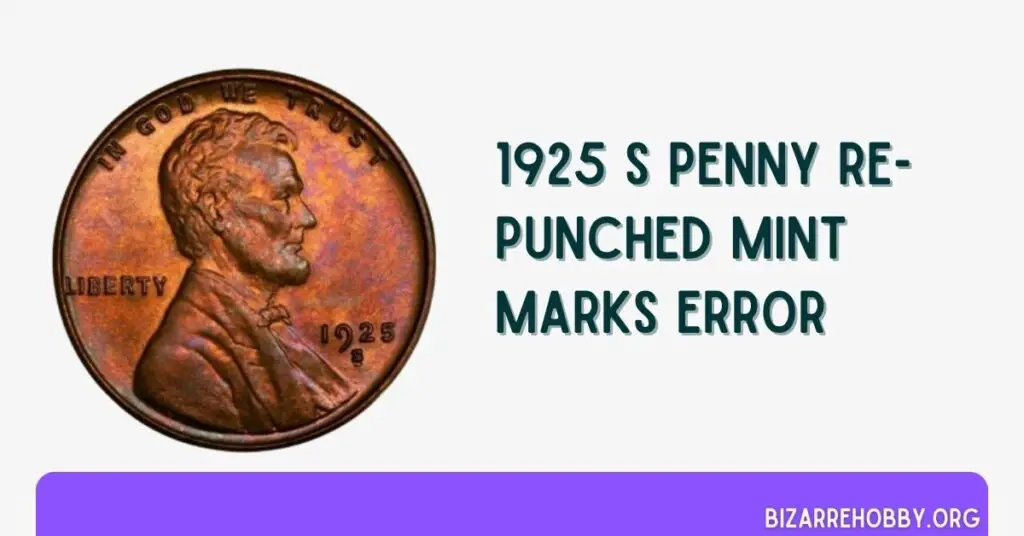
Re-punched mint marks occur when the mint mark is struck more than once, resulting in a visible overlap. For the 1925 S penny, you might see the lower curve of the first “S” beneath the second.
Values for re-punched mint mark 1925 S pennies also depend on their condition:
- Poor Condition: Around $27
- XF45: Approximately $120
- MS60: About $260
- MS65 Red: Valued at $43,000
Where to Sell Your 1925 Penny?
Knowing the value of your 1925 penny is just the first step. Selling it at the right place can maximize your returns. Here are some recommended platforms to sell your coins online, along with their pros and cons:
- eBay: Wide audience, auction format, but fees can be high.
- Heritage Auctions: Trusted auction house, good for high-value coins, but may take longer to sell.
- Coin Shows: Direct interaction with buyers, immediate sales, but requires travel.
For a detailed list of the best places to sell coins online, including their pros and cons, check out this guide: Where To Sell Coins Online? [Pros & Cons].
What to look for in the 1925 Penny?
When examining a 1925 penny, there are several key features and factors to consider that can significantly impact its value:
- Mint Mark: Check for the presence of a mint mark below the date. A “D” indicates it was minted in Denver, while an “S” signifies San Francisco. No mint mark means it was struck in Philadelphia. Mint marks can affect rarity and value.
- Color: The color of the penny is crucial. Red pennies, which retain their original copper color, are more valuable than red and brown or brown pennies. The color grading (red, red and brown, or brown) can significantly influence the coin’s market price.
- Condition: Assess the coin’s condition using the Sheldon Scale. Coins in higher grades (MS60 and above) are more valuable. Look for signs of wear, scratches, and overall preservation. Uncirculated coins (mint state) are particularly prized.
- Errors: Identify any mint errors, such as double die obverse (DDO) or re-punched mint marks. These errors are rare and can substantially increase the coin’s value. Use a magnifying glass or microscope to spot these details.
- Historical Context: Understanding the historical significance of the 1925 penny can add to its appeal. This coin is part of the Lincoln series, which was the first to feature a real person on U.S. currency, commemorating President Abraham Lincoln.
By carefully examining these aspects, you can better determine the value and rarity of your 1925 penny.
FAQs on 1925 Penny Value
How many 1925 pennies were made?
In 1925, the Philadelphia Mint produced over 140 million pennies, the Denver Mint struck over 22 million, and the San Francisco Mint produced over 26 million. While these numbers might seem high, they are relatively low compared to modern mintages. For instance, in 2015, the Philadelphia Mint alone produced 4.7 billion pennies.
What year is the most valuable penny?
The most valuable pennies are often those in the finest condition from any mintage. However, the 1943 steel wartime cents are particularly prized by collectors. The auction record for a penny is held by a 1943 penny struck in error on a bronze planchet, which sold for an astonishing $840,000 in January 2021.
Final Thoughts
The 1925 penny is a fascinating piece of American numismatic history, offering collectors a glimpse into the past. Whether you’re a seasoned collector or a curious novice, understanding the factors that influence the value of this coin can enhance your appreciation and potentially increase your returns.
From mint marks and color to condition and errors, each detail plays a crucial role in determining the worth of your 1925 penny.
